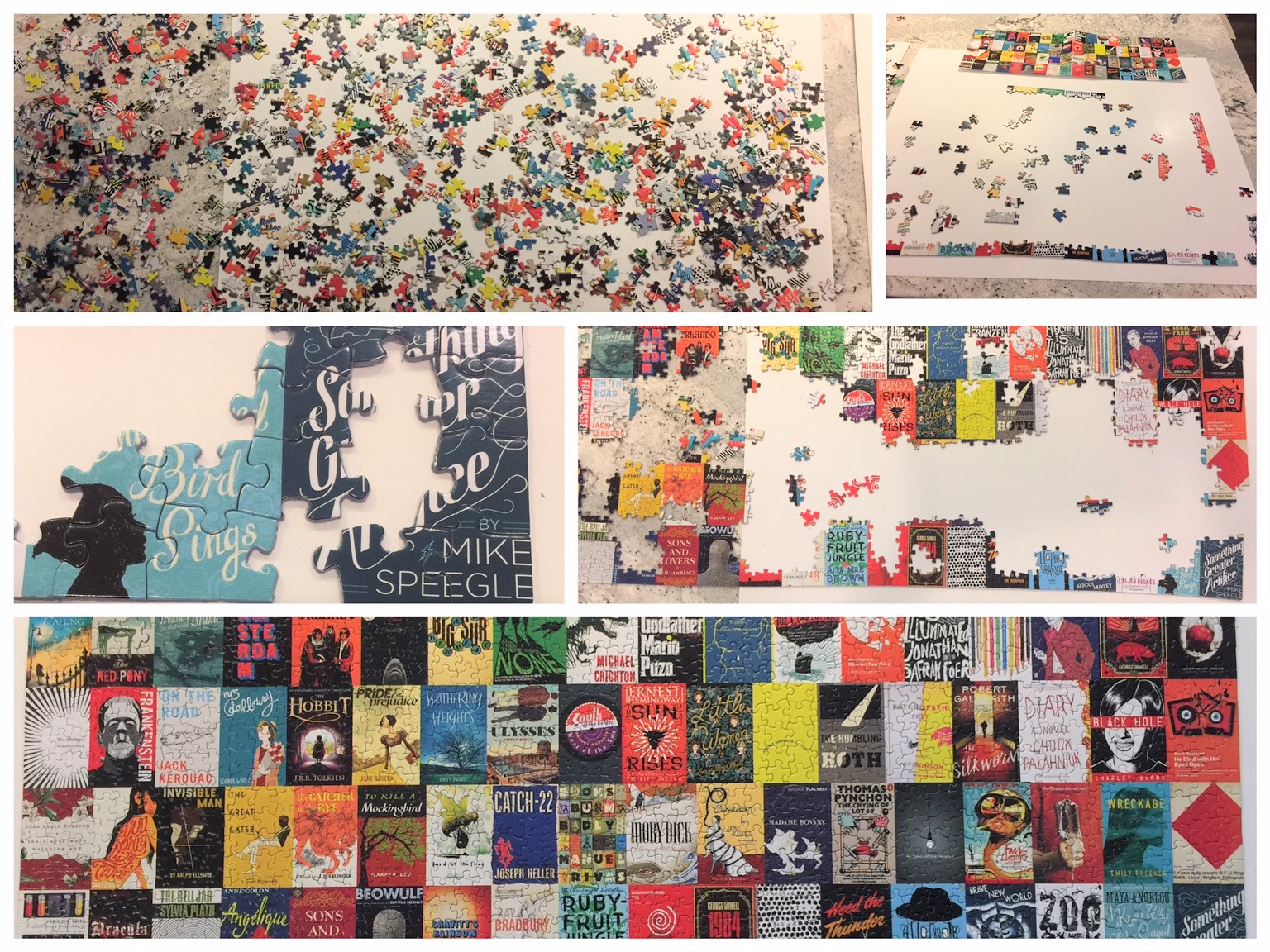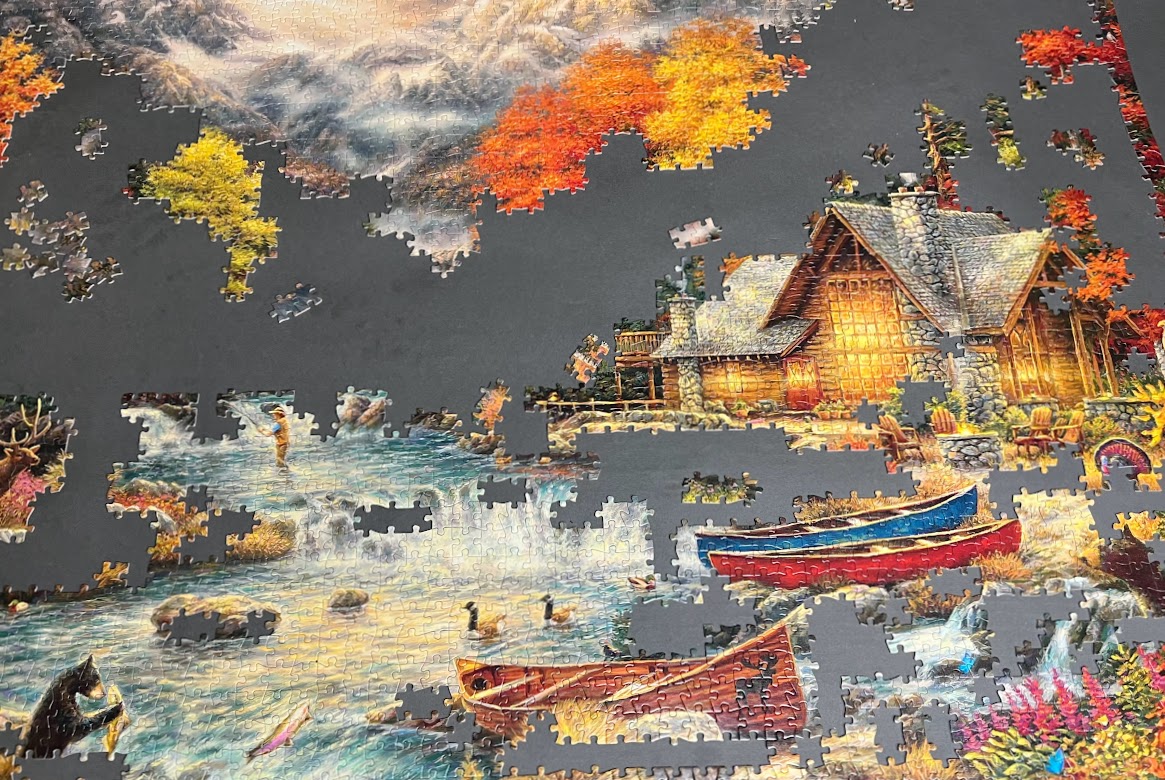Jigsaw puzzles are fun, meditative, mindless, and dopamine-filled. It’s a good way to stop scrolling. Listen to some music, have some coffee, and puzzle with your spouse. The good life.
I have 10 reasons why this is a useful metaphor for problem solving. Some nerd-consulting comments in red color. Then at the very bottom, I have another 10 reasons why jigsaw puzzles are WAY easier and more fun than consulting in blue.
1. Start with easy ones
Puzzles come in LOTS of sizes and difficulty. Knock out a few puzzles with distinct lines and colors that area easy to put together. Then you can graduate to 2,000 piece puzzles of impressionism; woof, they are hard.
- Set yourself up for success by really asking a lot of client-discovery questions up-front
- Get help if needed; there’s no glory in struggling by yourself, then doing average work
-
Does this project needs to be scoped down? Should we do an assessment first (for less $$), then implement?
2. Look at the box
What problem are we trying to solve? Can you imagine solving a 1,000 piece puzzle without any clear notion of the picture? Is this a picture of a dog, vegetable, or TV show. What’s the end goal?
- Read the statement of work, what did we promise?
- Speak with the client, what does success look like?
-
What do similar client deliverables look like?
3. Start with the edges
We all know this. This is where you start. There are only so many pieces with a flat side; it immediately tells you where it goes (top, bottom, left, right). Same with project scoping; what are the edges of the puzzle?
- How big and broad is the problem? What’s included?
- All business units, processes, customers, and products?
- Is the deliverable a 10 pg executive summary, or a live dashboard API?
4. Put things in buckets
Group the colored pieces together and make it easier to find what you are looking for. Yellow over here. Red color there. Organize your station so everything is easy to find. Get things ready.
- How to divide up the problem into pieces?
- Which team member will work on which problem?
- What pieces of the puzzle do you already have vs. what you still need?
- What are the economic drivers of this problem? What will move the needle?
- What are common frameworks to divide this problem into MECE buckets?
5. Look for patterns
What do you see? Anything easy that you can solve immediately? Do the easy parts first, this has the benefit of a) giving you some momentum b) reducing the number of remaining pieces to deal with. This is what consultants excel at. Uncover patterns among the mess of pieces (client data) and find the links (correlation).
- Are there some obvious things to fix now? Any quick wins?
- Start client conversations and uncover the as-is situation? What’s worked? What’s broken?
- Has as similar project been completed by the client and failed?
- What other initiatives (both larger and smaller) might affect this project scope?
- Be willing to re-sort, re-group, and reorganize the data? Your first grouping is not necessarily right
6. Search for specific pieces
Depends on the difficult of the puzzle, but find the distinct lines, and hints that send you on a curiosity-filled hunt. Except that you will have good days, and bad ones. Good days when you uncover a useful insight, and other days where you still don’t have the data.
- Use hypotheses (educated guesses based on available information) to clarify your thinking
- What do you think the answers could be? How can you prove/disprove that?
- Do we need to “create” data through surveys, proprietary research, or modeling?
- Get creative; the client didn’t hire you to ChatGPT, they could have done that themselves
- Dig deep. This would not be a strategic initiative or a consulting project if it were easy, or obvious
7. Be open-minded
When searching for pieces A, you can scoop up other pieces B, C, and D that go into other parts of the puzzle. Serendipity? Remember that strategy = good decisions + luck. Yes, there is definitely some luck in puzzling, and work
- Your interviews, surveys, benchmarking, and research may send you in new, different directions
- Share your findings with the client, and sister project workstreams; don’t be an island
- Be cross-functional; rarely do Fortune500 company (enterprise-sized) problems sit only in 1 function
- Look upstream; this process is likely affected by 2-3 other processes (is the problem up the river?)
- Think through implementation; what’s needed to make potential recommendations stick?
8. Have fun
I’ve only done 10+ puzzles in my adult life, but it’s great fun. Dopamine is a happiness chemical that kicks-in when you see some of the progress you are making. One more piece. Pride in your work.
- Demonstrate progress through your interim deliverables, analyses, and status updates
- Celebrate some of your small wins. Take care of your team. Engage your client afresh.
- Don’t make it boring, learn something; apprentice a teammate, or work on your client skills
- Be a leader; take more of the blame and give away more of the credit; compliment a client in front of her boss
- Take pride in your work; consultants are practitioners. . which means you need to practice
9. Work in teams
This may be the most important point (hat tip: Ulysses in comments). The hardest puzzles – the ones that are the most challenges, most fun, and most engaging – are more than one person’s burden. (thanks: SK)
- Unless you are a 1-person subject-matter-expert (SME) who is writing a report, most work is cross-functional
- How can you help someone else’s work? How can someone else help you?
- Ask this questions daily of your team: “Anything you need from me?”
- Use your client’s brain; they are smart in ways you are not; they also know the organization better than you
- Think about how to stitch together the final deliverable; how does this all come together into a story?
10. Pace yourself
Rarely is a puzzle done in one weekend. Stand-up, do something else, then come back. Put the puzzle in a public place (e.g., near the kitchen), where you can drop-in, fit a few pieces, then walk away.
- Yes, projects can be a slog. There is a LOOOONG middle, when it sometimes feels like you’re not making progress
- Work backwards from the answer; what is needed by when? what does success look like this week?
- Start socializing your results; don’t wait for a BIG REVEAL at the end of the project. Start getting client votes now

UH OH – Not a perfect metaphor
Okay, now comes the “adulting” part of the blog post. Puzzles are recreation; management consulting is not. Clients pay $$$,$$$ for your highly effective and efficient work. So, there are many ways ways that consulting projects are different:
- Clients do not always agree on what the picture should be (CFO vs. CMO vs. CHRO)
- There are missing pieces (data sets) all the time
- There are extra pieces (random, useless, uncorrelated data) which confuse the puzzling
- The data does not always fit together nicely; tons of cleansing of data, cross-walking data
- Projects have deadlines; you can’t finish it at your leisure
- Client often work on the same puzzle – in parallel – which can mess up your flow
- Sometimes, you join when the puzzle is half done (or messed up); another consulting firm’s mess
- Clients want you to teach them how to puzzle in the future without you
- During your assessment project, you don’t get to touch the puzzle (implementing the solution)
- You don’t like the puzzle, you didn’t pick it; it’s an ugly picture
This is the difficult one we are working on Now
This is based on a painting by a friend of mine – Chuck Pinson. You can get his art and puzzles here (affiliate link).


Great post! And a cool puzzle!
Thanks. Also, sadly I have only read 20% of the books. Mostly in high school. Shame. Shame. Shame. Heh heh.
Good job!! And don’t forget it much better when you are working in groups!
I like that a lot. That may be the main point. Adding that into the blog thanks.
Thank you for this article with an apt analogy. Exactly what I needed today.
Thanks for reading.
Very interesting puzzle and a distinct way of explaining consulting in a very organized way. Business strategy consulting services helps to keep the marketing plan in place. The projects are on scope and on budget. For small business strategy consulting is extremely helpful to develop a successful business plan. I was able to do it concisely with http://www.introviz.com as they have experienced team of consultants who helped me streamline my business activities as per my goals.
It reminds me of the school days when I was playing the Jigsaw puzzle. But I never imagined that it was so helpful in developing an analytical mind. We always should be knowing about group work and have a problem-solving approach as consultants always.
Yes, seems like the analogy between games & problem solving & business problems is stronger than ever. Agreed.
Just seeing this now, but boy…. DEAD ON. Thanks for sharing your brain, and some great insights!
Thanks for reading.